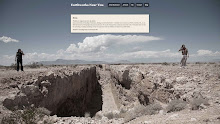
Arriving at the artwork involved a third party. We were not able to drive through the private ranch roads unless accompanied by someone working for Marsh Enterprises. What was so different about this experience vs. Lightning Field is that the third party hung out with us, inserted himself in our photographs, and protected us with his BB gun. This was very strange in comparison to the solitary nature we had with most of the earthworks. After we disappeared over the edge of the piece to conduct a burial, LBK left us alone for awhile, positioning himself on the hillside above, sitting in the truck watching us (sound familiar?). We were far more comfortable with LBK's presence than Jimbo's at Roden Crater because we were welcome here.

We first arrived to see obnoxious green rocks leading us to the end of the artwork. These were LBK's concoctions - the paint chipping away but still a very apparent and distracting element when viewing the sculpture. They were a shocking and disruptive interference to all the red rocks and cacti growing along the edges. Some of the cactus were even spray painted a shimmery silver. LBK's is thankfully allowing the paint to disappear (without a fresh coat).

Amarillo Ramp was far larger than the shrinking image we had anticipated. Everything we read and all the current photographs we saw depicted it as far less of an artwork than it originally was. We were quite surprised that it wasn't vanishing into the landscape in a more dramatic way. The ascent was still quite steep despite it being 3/4 it's original size. Also when compared to the original photographs just after the artwork was finished, there is no vegetation. Now the edges are obviously rounded with erosion but the sheer amount of growth on the artwork itself, gives the impression that it is far smaller.

Unlike Spiral Jetty, Amarillo Ramp gave us a lookout point - even though it's not very high, it's enough to give a different perspective. The presence and absence of water is also a point of discussion. Amarillo Ramp once had water (but the lake was drained) to construct the piece. The presence of water at Spiral Jetty is always in flux and no one ever really knows what the earthwork will look like. At the Ramp, the "caretakers" are the primary element that change the work most drastically, not the environment. It is allowed to deteriorate through the hands of other artists not strictly nature.

Cows are a dominate presence in the landscape. Their feces was seen (and avoided) on the top of the artwork as well as 100 feet away, gradually moving closer to us as the afternoon progressed. Nancy and I were also impressed with the largest grasshoppers we had ever seen mating in the cacti.
We could have been out there far longer but we knew LBK was waiting on us and we had zero gas for him to sit in the truck with the A/C on. This was the first time that heat was not a deciding factor on when we would leave. We never did discover where Smithson's plane crashed (LBK wasn't going to reveal this information anyway telling us that he would point in two directions and we would have to decide) but that wasn't necessarily a disappointment. He was genuinely surprised we stayed as long as we did as most people walk down, see the artwork, ring the bell, and return to the car. Because this work was owned by private hands, it felt odd not to pay for this experience and LBK's time. We are grateful and as odd as it was, we would still consider doing it all over again.

No comments:
Post a Comment